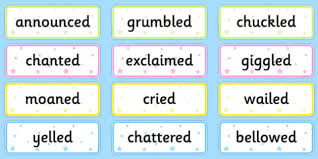Dialogue tags aren’t the only way to distinguish which character is speaking, but they sure are handy to have in your writer’s toolkit. Another way to distinguish characters during dialogue passages is by describing actions related to each character. In practice, I like to mix it up. And when just two characters are having a conversation, you may only need to tag one. But whenever, however, and wherever you choose to insert dialogue tags, it helps to know the punctuation rules.
 Are you surprised to learn that the most common tags are he said and she said? The reason is because they’re practically invisible. To prove this point, turn to the last book you read and examine the dialogue. How many times did you notice the use of he said or she said? Probably not many.
Are you surprised to learn that the most common tags are he said and she said? The reason is because they’re practically invisible. To prove this point, turn to the last book you read and examine the dialogue. How many times did you notice the use of he said or she said? Probably not many.
 If you write “John screamed” or “Melanie whispered furtively,” it adds depth to your dialogue and helps capture the proper urgency. Trust me when I warn you that those fancy tags stick out. If you sprinkle them in judiciously, that’s great. But if you use them all the time, they’ll OVERWHELM your dialogue. I’ll get off my soapbox now and introduce the punctuation rules for dialogue tags placed first, last, and in the middle.
If you write “John screamed” or “Melanie whispered furtively,” it adds depth to your dialogue and helps capture the proper urgency. Trust me when I warn you that those fancy tags stick out. If you sprinkle them in judiciously, that’s great. But if you use them all the time, they’ll OVERWHELM your dialogue. I’ll get off my soapbox now and introduce the punctuation rules for dialogue tags placed first, last, and in the middle.
WHEN DIALOGUE TAGS COME FIRST
1) Place a comma after the tag and before the beginning quotation mark.
2) A period, exclamation mark, or question mark will go inside the closing quotation mark, at the end of the sentence.
3) Dialogue within quotations starts with capital letters, just like a regular sentence.Examples
-She said, “I’m taking AP Chemistry next year.”
-Steve asked, “Where are we meeting?”
-Mr. Minor screamed, “Get that car off my lawn!”
WHEN DIALOGUE TAGS COME LAST
1) If the quoted dialogue ends with a PERIOD, change it to a COMMA.
The period should be placed at the end of the sentence, after the dialogue tag.
2) Don’t capitalize dialogue tags unless they start with a proper name or I.
**Your spell checker may indicate that capital letters are indicated. That is incorrect!**
3) If the quoted dialogue ends with a QUESTION MARK or EXCLAMATION MARK, keep it. Still put a period at the end of the sentence, after the dialogue tag.Examples
-“I’m getting a new laptop,” Jane said with glee.
(When putting “with” after said, no comma is needed.)
-“Are you ready for the test?” he asked, shifting from foot to foot.
(When adding a physical detail directly after the tag that’s happening at the same time as the dialogue, precede it by a comma and use the “ing” verb form.)
“Don’t make so much noise!” yelled the teacher.
(Dialogue tags don’t start with capital letters, even if following exclamation marks or question marks!)
WHEN DIALOGUE TAGS COME IN THE MIDDLE
These are the trickiest tags, so I’ll show an example before describing each rule.–“Hurry up and come downstairs,” John’s mother called, “or your dinner will get cold.”
1) If the dialogue tag splits a single sentence, use commas before and after the tag. Start with a lower case letter when resuming your sentence in the 2nd quote.–“I’ll have to say no,” Marilyn said, flipping her hair. “I’ve had far better proposals than the one you’re offering.”
2) This is actually a case where “the dialogue tag comes last,” with a new sentence following. (You don’t need to tag again in this case, as it’s crystal clear who is talking.)–“That sounded great!” the band director announced. “Now play it one more time for good measure.”
3) This is another case where “the dialogue tag comes last,” but this time with an exclamation point ending the first sentence. (To repeat, when dialogue ends in either an exclamation point or question mark, keep them, but still put a period after your dialogue tag.)
4) This rule stands no matter where you place your dialogue tags. Only words that designate speech can work as dialogue tags!
Did you notice that ALL ENDING PUNCTUATION goes INSIDE the quotes? That’s true of all dialogue, whether or not you use tags!!!
 If you would enjoy receiving punctuation, grammar, and vocabulary advice in short, witty, easily swallowed doses, check out my weekly blog, A Spoonful of Grammar.
If you would enjoy receiving punctuation, grammar, and vocabulary advice in short, witty, easily swallowed doses, check out my weekly blog, A Spoonful of Grammar.


Great post, Laura! I love that we have access to your knowledge at all times by clicking on A Spoonful of Grammar!
LikeLiked by 1 person
“Thank you, Marcia, for being one of my biggest supporters!” Laura gushed.
LikeLike
You are a punctuation guru, Laura. Good reference material, so thanks.
LikeLiked by 1 person
“Thank you, Joyce!” Laura said, jumping up and down with glee.
LikeLike
“A nice dialogue punctuation reminder,” said Kelly.
LikeLiked by 2 people
“Thank you for your comment,” said Laura with a grin.
LikeLiked by 1 person